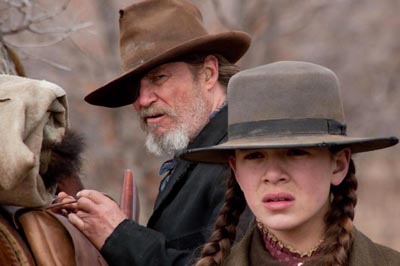 Painting in a dozen shades of sepia, the Coen brothers take us back into the last century when there was plenty of frontier still left in Arkansas and the law was still a gleam in Wyatt Earp’s eye.
Painting in a dozen shades of sepia, the Coen brothers take us back into the last century when there was plenty of frontier still left in Arkansas and the law was still a gleam in Wyatt Earp’s eye.
Our first glimpse of Jeff Bridges as the “one-eyed fat man” Rooster Cogburn is a long slow shot across a smoky courtroom. You have to look twice to recognize him through the unmistakable ghost of John Wayne, who is given a moment of homage by the Coens in their slim, lyrical telling of Charles Portis’ tale.
Sticking close to the book in words and unvarnished attitude, the Coens and their cinematographer Roger Deakins take us into what must have been an all-too-common world of of post-Civil War desperation, dislocation and desperadoes. Â Men simply did what they had to do to get by, life was cheap and death was simply one of the few options poor and uneducated men had after their worlds were destroyed by the war.
As Mattie Ross, the crafty vengeful youngster tracking her father’s murderer, Hailee Steinfeld looks crisp and spunky, but the film belongs to Jeff Bridges as Rooster Cogburn), a low-key Matt Damon as Texas Ranger LaBoeuf, Josh Brolin as the murderer Tom Chaney, and Barry Pepper as outlaw Lucky Ned Pepper.
Two things are particularly rich and rewarding about this modest yet unforgettable screen tale. One is the Coen’s twinkling eye for cinematic quotes — Bridges is, for one spellbinding moment, the spitting image of The Duke (who won his only Oscar for his portrayal of Rooster 30 years ago). The haunting soundtrack uses the old spiritual “Leaning on the Everlasting Arm” to announce the quest of our anti-heroes. That was the very song threaded through one of the great American quest films – Night of the Hunter – in which Robert Mitchum is both hunter and hunted. Finally, the touch I most enjoyed, was Barry Pepper’s portrayal of Lucky Ned Pepper. The moment he began speaking to the feckless little Mattie, Pepper disappeared and what we saw and heard was Robert Duvall, who played the same role in the earlier screen version of True Grit. It is a brilliant and witty little turn, and an homage to one of our great interpreters of Western iconography.
Which brings me to the second reason why True Grit has so captured the conscience of the American filmgoer at just this moment. My British friend asked me last night at dinner, “Just what is it about westerns that Americans seem to love?” Obviously there are many answers to that question, but I’m thinking that right now a few stand out. No doubt many boomers recall fondly the early days of TV, The Lone Ranger, The Cisco Kid, playing cowboys and Indians in the backyard, watching old John Wayne movies and new spaghetti Westerns. It was a simple, and simplistic world of clearly defined “good guys” and “bad guys.”
But the bigger thing is the chance to watch an earlier, more innocent (if rough) moment in our shared journey. The West meant a place where you could spread out and unfold your dreams. Cowboys were men who slept under the stars, lived dirty and drank hard. It would have been possible to escape rigid social codes, legal red tape – in this True Grit young Mattie mentions the word “law” as if it had magical transformative properties – in essence, a tantalizing sort of personal freedom could be had for the price of leaving everything behind and taking a chance. (Yes, I am romanticizing here.)
Westerns – with all of their myopic narrative baggage, their lionizing of heroes, their meting out of instant Colt revolver justice – appear as a refreshing antidote to the suffocating plaid of postmodernism. Clarity is both bracing and spiritually renewing – even if it’s only make-believe.


We loved it also, but you noted several things i missed. I’ll share it with Harvey. What did you think of the scene near the end when he is carrying her for miles? I thought that it was tipping the hat to the old, much less techno films of the 40’s to the 60’s.
Claudia – I think you have a good point. Certainly the arduous journey back for both Rooster and Mattie quotes every great “rescue and redemption” tale from Orpheus and Euridyce to Heathcliff and Catherine.
The cinematography deepens the sense that we are watching an archetypal moment.
All those stars keeping watch over our two orphans in the storm.
I think I’ll go see True Grit again!
xxx
Christina